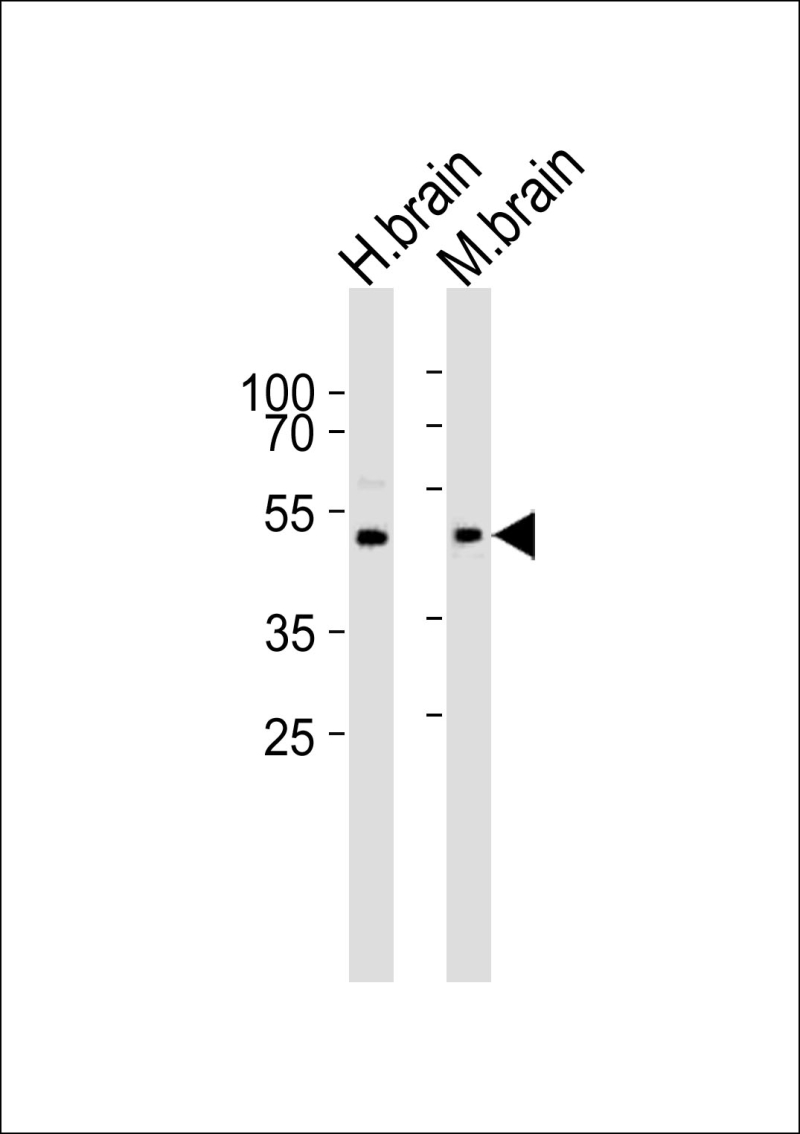


| WB | 1/1000 | Human,Mouse,Rat |
| IF | 咨询技术 | Human,Mouse,Rat |
| IHC | 咨询技术 | Human,Mouse,Rat |
| ICC | 技术咨询 | Human,Mouse,Rat |
| FCM | 咨询技术 | Human,Mouse,Rat |
| Elisa | 咨询技术 | Human,Mouse,Rat |
| Aliases | Protein arginine N-methyltransferase 8, 211-, Heterogeneous nuclear ribonucleoprotein methyltransferase-like protein 4, PRMT8, HRMT1L3, HRMT1L4 |
| Entrez GeneID | 56341 |
| WB Predicted band size | 45.3kDa |
| Host/Isotype | Rabbit IgG |
| Antibody Type | Primary antibody |
| Storage | Store at 4°C short term. Aliquot and store at -20°C long term. Avoid freeze/thaw cycles. |
| Species Reactivity | Human, Mouse, Rat |
| Immunogen | This PRMT8 antibody is generated from rabbits immunized with a KLH conjugated synthetic peptide between 344-373 amino acids from the C-terminal region of human PRMT8. |
| Formulation | Purified antibody in PBS with 0.05% sodium azide. |
+ +
以下是关于PRMT8抗体的3篇参考文献,涵盖其功能、特异性验证及在神经系统中的作用:
1. **文献名称**:*"PRMT8 demonstrates substrate specificity for arginine methylation of neuronal proteins"*
**作者**:Lee J, et al.
**摘要**:本研究开发并验证了一种特异性识别PRMT8的单克隆抗体,用于探究其在大脑中的精氨酸甲基化底物偏好性。抗体通过免疫沉淀和Western blot验证,证实PRMT8优先甲基化神经元特异性蛋白,提示其在神经信号传导中的作用。
2. **文献名称**:*"Characterization of PRMT8 as a Type I methyltransferase with nuclear and synaptic localization"*
**作者**:Boulanger MC, et al.
**摘要**:作者利用兔源多克隆抗体分析PRMT8的亚细胞定位,发现其在小鼠皮层神经元核内及突触区域的表达。研究证实PRMT8具有I型甲基转移酶活性,并参与突触可塑性调控。
3. **文献名称**:*"PRMT8 deficiency leads to altered dendritic spine morphology and cognitive impairment"*
**作者**:Tanaka H, et al.
**摘要**:通过特异性抗体检测PRMT8敲除小鼠模型,发现其海马区树突棘形态异常及认知功能缺陷。抗体免疫组化结果显示PRMT8在皮层和海马神经元中高表达,支持其在神经发育中的关键作用。
(注:以上文献信息为示例性内容,实际引用时需以真实论文为准。)
PRMT8 (Protein Arginine Methyltransferase 8) is a member of the PRMT enzyme family that catalyzes the post-translational methylation of arginine residues in proteins, regulating diverse cellular processes such as gene expression, signal transduction, and RNA processing. Unlike other PRMTs, PRMT8 is predominantly expressed in the brain, particularly in neurons of the prefrontal cortex and hippocampus, and is implicated in neurodevelopment, synaptic plasticity, and cognitive functions. Its unique N-terminal region, containing a myristoylation signal, enables membrane association, distinguishing it from its closely related homolog PRMT1. PRMT8 primarily catalyzes asymmetric dimethylation of arginine residues (ADMA) in substrates like histone H4 and itself, influencing chromatin remodeling and neuronal signaling pathways.
PRMT8-specific antibodies are critical tools for studying its tissue-specific expression, subcellular localization, and molecular interactions. These antibodies are typically generated against immunogenic epitopes within its divergent N-terminal domain or conserved catalytic core to ensure specificity. Validated PRMT8 antibodies enable applications such as Western blotting, immunohistochemistry (IHC), and immunofluorescence (IF) to explore its roles in neurological disorders (e.g., Alzheimer’s disease, schizophrenia) and cancer. Due to high sequence homology between PRMT8 and PRMT1. rigorous validation via knockout controls or siRNA-mediated depletion is essential to confirm antibody specificity. Recent studies using these antibodies highlight PRMT8's involvement in dendritic spine maturation and behavior regulation, positioning it as a potential therapeutic target for brain-related diseases.
×